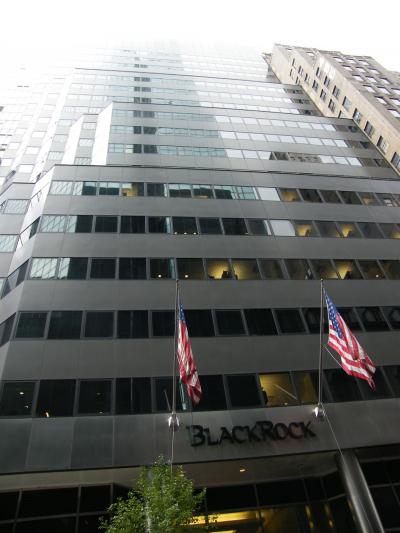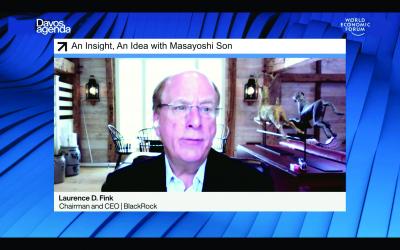BlackRock’s March to World Power
Besides the British Monarchy, only one other entity has become as nearly synonymous with the agenda of the Great Reset: Black Rock. It was BlackRock that announced the agenda of “regime change” at the August 2019 central bank forum in Jackson Hole, where a central banker’s dictatorship was to impose a green agenda that would lead to the British Monarchy’s dream of global depopulation. It is BlackRock, along with Vanguard and State Street, that make up the Big Three of the “asset managers”—whose assets under management surpass the GDP of China. While BlackRock’s actual ownership of $165 billion in assets is relatively small as compared to the $3,100 billion of assets owned by the largest U.S. bank, JPMorgan Chase, BlackRock’s power does not come from its actual assets, but rather those it has under management. So where did they get this immense power?



An evil “taxonomy”: From the towers of Goldman Sachs (left), JPMorgan Chase (right), and first and foremost BlackRock, Inc. (center), companies around the world are being told to stop investing in fossil fuels and their technologies, and to make investments in a new “green finance” bubble instead.
A New Venetian ‘Fondi?’
Like the fondi of Venice—funds that could be accessed for the lavish lifestyles and political dealings of the Venetian Oligarchy but never drawn down—BlackRock plays a similar role in asset management of the City of London and their branch office in Wall Street. Following the repeal of the Glass–Steagall firewall between speculative financial activity and commercial banking in Franklin Roosevelt’s Banking Act of 1933, giant banks such as JPMorgan Chase and Goldman Sachs—which have supplied, and hired, one top public official after another—became the rulers of this increasingly deregulated world.
However, after the famous “Lehman moment” of 2008, some elementary prudential rules were enacted to try to prevent excessive speculation and systemic risk. Wall Street lawyers and greedy money sharks, of course, invented smart ways to sail around these obstacles. Armed with super-powerful computers using sophisticated algorithms, the “Big Three” giant asset managers (BlackRock, Vanguard and State Street), became the kings of the day. Information is power, and they controlled that information. Here is how it happened.
As in Silicon Valley, Algorithms Decide: Black Rock’s Magic Lamp of Aladdin
In the immediate aftermath of the 2008 meltdown, it was nearly impossible to separate trash financial paper from legitimate assets. Enter BlackRock’s “Aladdin” (Asset, Liability, Debt and Derivative Investment Network). This electronic application—a cluster of 6,000 high-performance computer servers constantly monitoring nearly $18 trillion in financial assets, 8% of the world’s total—now keeps track, in real time, of some 30,000 investment portfolios, including BlackRock’s own along with those of competitors, banks, pension funds, and insurers.
Thanks to this highly sophisticated computer system managed by a 2,000-person army of mathematicians and IT specialists, BlackRock, in a joint venture with Google, has shifted part of its investments from human analysts to the algorithms of its artificial intelligence platform.
Equipped with this very powerful analytical tool, and having access, as a major shareholder, to the balance sheets of a huge part of the Western economies, BlackRock has been increasingly called on to advise governments in crisis situations

Laurence Fink, Chairman and CEO of BlackRock, Inc., the world’s largest asset management firm, with more than $6.5 trillion in assets under management, speaking at the Davos Agenda 2021 World Economic Forum.
Since 2008, new technologies have transformed the world of finance. First, the spectacular advancement of computer technologies, notably the development of High Frequency Trading (HFT), has brought many private as well as institutional investors to shift capital from “actively” managed mutual funds to “passively” (computer) managed index mutual funds and “exchange traded funds” (ETFs).
While active management requires traders and fund managers who try to buy stocks that will outperform others, “passive” management—the use of mathematical algorithms—turns out to work better, and to be safer and cheaper. When the stock market rises steadily, tracking a stable basket of values with an algorithm brings greater returns than analysts’ intuitions. Academic research regularly demonstrates this.
This capability has lead to BlackRock’s meteoric rise to power, as the world’s largest asset manager, with $8.67 trillion in assets under management as of January 2021. For BlackRock, index “products” represent more than $5 trillion of that total. Today, BlackRock employs 13,900 people spread over 30 countries, tasked with selling financial products or investing in new companies. With the profits earned by selling financial advice to pension funds and institutional investors, BlackRock bought shares of 17,000 companies and firms, not only in the United States but worldwide—and they never fail to vote at each general meeting.
French economic journalist Grégoire Favet writes:
As soon as BlackRock appears as one of your shareholders, your company stands out from the crowd and gains a huge amount of prestige. When you are Larry Fink, you can talk as equals with the director of the IMF or a head of state.
BlackRock’s Larry Fink has already been received twice at the Élysée since the election of Emmanuel Macron.
Hence, the Big Three (BlackRock, Vanguard and State Street) together constitute the largest shareholder of all U.S. corporations and are the largest shareholder in each of 88% of the S&P 500 firms.
BlackRock’s Real Capital—Political Capital
While it was the shift towards passive fund management, coupled with the supercomputers of Aladdin, which gave BlackRock its power as an asset manager in the aftermath of the 2008 meltdown, its real assets lie in the control of “political capital.” As an “asset manager,” BlackRock avoids regulation applied to the sketchy financial products of investment banks and hedge funds, because Fink and BlackRock “pushed hard to successfully resist the designation of asset managers as systemically important financial institutions (or SIFIs), which would be subject to additional regulation like larger capital requirements,” according to The Intercept in 2016. BlackRock has also in recent years conducted “stress tests” for the Federal Reserve and European Central Bank, yet has interests in the very same assets of those banks and financial entities who are a part of these central banks. Is that not a blatant conflict of interest?
In 2009, U.S. Senator Chuck Grassley asked the same question about this conflict of interest, between auditing on behalf of the public sector while investing in the private sector:
How is it that only one company is qualified to manage these assets recovered by the government? They have access to information about when the Fed will try to sell securities and at what price. And they cultivate highly developed financial relationships with people around the world. The potential for a conflict of interest is great and it’s complicated to regulate.
BlackRock has set its sights on Europe and spends heavily to recruit top political figures possessing large address books. Notably this includes the failed successor of Chancellor Merkel, Friedrich Merz; the former head of the Swiss National Bank, Philip Hildebrand; the former UK Finance Minister George Osborne; or Paschalis Bouchoris, the former head of the Greek privatization program. Larry Fink can fly to Europe and in less than five hours get an appointment with most EU presidents, prime ministers, or CEOs of large corporations.
For Biden, Only BlackRock’s Life Matters
This year’s Davos “Great Reset” agenda meeting has no doubt accelerated the transition into green finance. It is no surprise that Joe Biden, who has made the Green New Deal his policy, picked several high-level officials of BlackRock to be part of his administration. BlackRock is also home to key figures in the fight to prevent the LaRouche movement’s organizing to reinstate the Glass–Steagall firewall between speculation and legitimate banking—the first step in LaRouche’s Four Laws.
As reported by David Dayen, in a 2016 article in The Intercept, Larry Fink, betting Hillary Clinton would win the elections,
assembled a veritable shadow government full of former Treasury Department officials at his company. Fink has made clear his desire to become treasury secretary someday. The Obama administration had him on the short list to replace Timothy Geithner. When that didn’t materialize, he pulled several members of prior Treasury Departments into high-level positions at the firm, which may improve the prospects of realizing his dream in a future Clinton administration.
The article continues:
“Fink also opposes efforts to reinstate the Glass–Steagall firewall between investment and commercial banks, as does [Hillary] Clinton.”
What BlackRock had wished to impose under Hillary Clinton and failed to impose under Donald Trump, it now hopes to implement under Biden. From the beginning, Biden’s donors had suggested that he appoint Larry Fink as Secretary of the Treasury! As a symbol, it was probably a bit too controversial as a starter. Instead, Biden appointed lawyer Adewale “Wally” Adeyemo, the former chief of staff to Larry Fink, as Assistant Secretary of the Treasury, that is, as the number two to Janet Yellen, Obama’s former Federal Reserve Chairman. Adeyemo got his start at the Brookings Institution’s Hamilton Project, and later became Treasury Secretary Jack Lew’s deputy chief of staff. He then operated as a chief negotiator for the major ultraliberal free trade agreement called the Trans-Pacific Partnership. Under Obama, in 2015, he was appointed Deputy National Security Advisor for International Economics and Deputy Director of the National Economic Council. He then became the first president of the Obama Foundation.
Next, Biden named Brian Deese as director of the National Economic Council. On BlackRock’s website, Deese’s CV reads as follows:
Brian Deese, Managing Director [of BlackRock], is Global Head of Sustainable Investing at BlackRock. The Sustainable Investing team is focused on identifying drivers of long-term return associated with environmental, social and governance issues, integrating them throughout BlackRock’s investment processes, and creating solutions for our clients to achieve sustainable investment return. Previously, Brian worked in the White House under President Obama where he was the President’s senior advisor for climate and energy policy, helping to negotiate the Paris Climate Agreement and other national and international initiatives.
Third, Michael Pyle, an Obama administration veteran who also worked on economic policy in Hillary Clinton’s presidential campaign and whom we mentioned before, was nominated as chief economist to Vice President Kamala Harris.
Joe Biden initially envisioned even nominating Tom Donilon, the president of the BlackRock Investment Institute (BII) as head of the CIA, but that didn’t materialize. Tom Donilon, besides being the brother of Biden’s main media advisor Mike Donilon, is a member of the Trilateral Commission and the Council on Foreign Relations, and has served on the steering committee of the secretive Bilderberg Meetings.
BlackRock is working overtime to bring a willing Biden into the British genocidal plan to “green” the world’s finance—not to save the climate, but to save their doomed and already collapsing empire of debt “assets” and fictitious capital.

Brian Deese (right), formerly Global Head of Sustainable Investing at BlackRock, and now the Director of President Biden’s National Economic Council, yucks it up with Al Gore and then-Secretary of State John Kerry in Paris in 2015.





